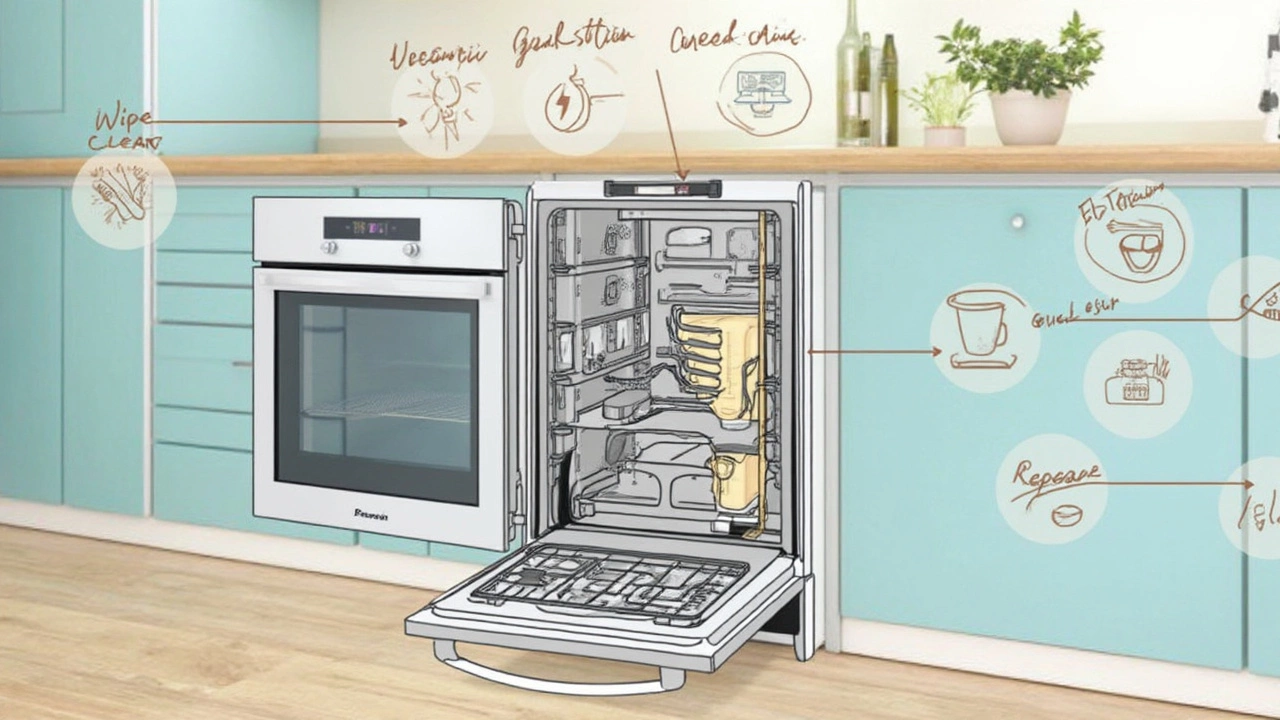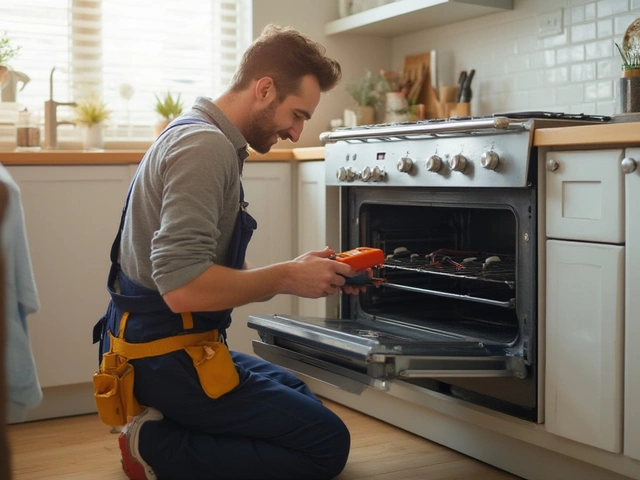If you’ve ever wondered whether an electric oven can actually make it 20 years, you’re not alone. Plenty of folks have that ancient workhorse in the kitchen, somehow still kicking after decades. But is that normal, or just dumb luck?
The truth is, most electric ovens are built to last around 13 to 15 years if you use them like a typical family does—some bread, a casserole here and there, maybe a frozen pizza on movie night. Getting past that and hitting 20 years usually means a combo of solid brand, gentle use, and some regular TLC. Skipping maintenance? That’s a fast track to calling your local repair guy way too soon.
It’s not just how old the oven is. How often you use those self-cleaning cycles (they’re rough on the electronics), how greasy those racks get, and whether you let little problems slide all make a difference. Ignore that weird smell or slow preheat, and those issues can snowball before you know it. Bottom line: Stretching an oven’s life takes a little effort and a sharp eye for small problems before they blow up.
- What Actually Impacts Oven Lifespan?
- Signs Your Oven Is Pushing Its Limit
- Smart Care for a Longer Lasting Oven
- Repair or Replace: Making the Call
What Actually Impacts Oven Lifespan?
Not all ovens make it to their 20th birthday. The way you use and care for your oven can change everything. Let’s break down what really matters if you want yours to last.
Oven lifespan depends on a blend of things, and some are in your control.
- Brand and Build Quality: Shortcuts in manufacturing show up later, usually around year 8 or 10. Sturdier brands with fewer fancy features often outlast flashy models.
- Usage Habits: If you’re baking or roasting daily, your oven is going to clock more hours and probably quit on you sooner. Occasional users? You’ll probably get a few more years.
- Maintenance: Grease buildup, clogged vents, and dirty heating elements can put your oven under stress. Just a quick clean every few weeks helps cooling fans and parts work as they should.
- Self-Cleaning Cycles: They sound easy, but these can actually fry the electronics. One study from a 2022 local appliance repair survey found that ovens with frequent self-clean cycles needed repairs 35% earlier than those cleaned by hand.
- Electrical Surges: Power spikes can zap control boards. Surge protectors are cheap insurance.
- Install Quality: An oven that’s crooked or wedged between cabinets with no breathing room will overheat and wear out parts fast.
If you like digging into the details, check out this handy table with average lifespans for different electric oven types based on actual field data:
| Oven Type | Average Lifespan (Years) |
|---|---|
| Standard Electric | 13-15 |
| Self-cleaning Electric | 10-13 |
| Wall Oven | 11-16 |
| Double Oven (Combo) | 9-12 |
Small choices make a big difference. Use gentle cycles, keep it clean, and don’t ignore little quirks. That’s how you squeeze the most years out of your oven.
Signs Your Oven Is Pushing Its Limit
Most ovens won’t just quit out of nowhere. They throw out warning signs first, and catching those early can buy you time or save you money. If you notice these red flags, your oven might be near the end of its run.
Oven lifespan isn’t just about age—a ten-year-old oven that’s breaking down all the time is more worn-out than a 17-year-old oven that’s barely missed a beat. Here’s what to watch for:
- Uneven cooking: If your cookies keep burning on one side but stay raw on the other, the heating elements might be wearing out or the thermostat’s gone flaky.
- Slow preheating: When it takes longer than 15 minutes to hit the target temp, something isn’t right. Most healthy electric ovens should be ready in about 10-15 minutes.
- Frequent error codes: Blinking numbers and weird beeps aren’t normal, even if you’ve learned to ignore them. Control boards can cost almost as much to replace as a new oven.
- Strange smells or smoke: Old ovens sometimes start cooking up electrical smells or give off smoke—not just from food spills, but from damaged wires or insulation inside.
- Noisy operation: If it’s buzzing, grinding, or clicking a lot, the fan or motor could be failing.
- Flickering or dim lights: It’s a small thing, but it often means electrical connections are going.
Here’s what usually goes wrong in older ovens—and how common these issues get after ten years:
| Common Oven Issue | % Reported After 10 Years |
|---|---|
| Uneven Heating | 47% |
| Control Board Fails | 31% |
| Broken Door Seal | 39% |
| Slow Preheating | 28% |
| Strange Odors | 22% |
If two or more of these are happening, your oven’s definitely on borrowed time. You might still squeeze out a few more months or years, but repair costs will start adding up—sometimes close to the price of a brand new machine.

Smart Care for a Longer Lasting Oven
If you want your oven to beat the odds and hit that 20-year milestone, regular care is a game changer. Most ovens don’t just die out of nowhere; they break down because little problems pile up. The good news? You can dodge most of them.
First, oven lifespan isn’t just about luck or brand. It’s about how you treat it. That means cleaning it, but not overdoing those self-cleaning cycles. Using the self-cleaning mode more than twice a year can fry critical parts, especially control boards and door latches. So wipe spills when they happen and skip the extreme heat unless you genuinely need it.
Grease and grime sneak into places they shouldn’t. Clean inside the oven door, along the seals, and under the heating element if it’s safe. Don’t let food buildup go unchecked—it makes your oven work harder and can lead to heating problems over time.
- Check the door seal every few months. If heat leaks out, cooking takes longer and stresses internal parts. Replacing the gasket is cheap and easy.
- Calibrate the thermostat yearly with an oven thermometer. If it’s running hot or cold, you’ll notice burnt cookies or half-cooked dinners—plus hotter circuits wear out faster.
- Don’t slam the door. That messes up hinges and alignment, making the seal less effective.
Here’s a quick look at what really helps your oven last:
| Maintenance Task | How Often | Pro Tip |
|---|---|---|
| Wipe spills and crumbs | Every use | Prevents smoke and food buildup |
| Deep clean (manual) | Monthly | Avoid harsh cleaners on sensors |
| Check door gasket/seal | Every 6 months | Replace if cracked or worn |
| Thermostat calibration | Yearly | Use a $10 oven thermometer |
| Vent cleaning | Every 12 months | Keeps electronics cool and dust-free |
One more thing: Surges and flickering lights aren’t just annoying. If you live somewhere with shaky power, plug the oven into a surge protector. Circuit boards are pricey, and a single zap can knock out your controls—there goes your savings on repairs.
Take care of the basics, listen for weird noises, and don’t ignore small changes in how it cooks. That’s how you get an electric oven to go the distance.
Repair or Replace: Making the Call
Okay, here’s the real question everyone runs into: is your oven lifespan up, or is it worth putting money into another repair? That call can mean the difference between saving a few bucks or wasting hundreds on something that’s never going to fully bounce back.
First, think about the age of your oven. If it’s pushing 15 years or more, and you’re running into back-to-back issues, you’re probably close to the end. Most manufacturers like GE and Whirlpool peg the expected life of an electric oven at about 13 to 15 years. After that, the likelihood of breakdowns or part failures goes way up.
But age isn’t the only factor. Ask yourself these quick questions:
- Is the oven starting to take forever to heat up?
- Are you seeing error codes or weird electrical glitches?
- Do repairs cost more than half the price of a decent new oven?
- Are finding replacement parts a struggle?
If you checked yes for any of those, a replacement is probably your best bet. But, for simple things like a broken heating element or a bad thermostat, repairs usually aren’t that pricey and can buy extra years.
Here’s a snapshot comparing average repair and replacement costs for electric ovens as of 2024:
| Issue | Typical Repair Cost (USD) | Average Replacement Cost (USD) |
|---|---|---|
| Heating Element | $150 - $300 | $700 - $1,500 (new oven) |
| Thermostat/Temperature Sensor | $120 - $250 | |
| Control Board/Electronics | $250 - $400 |
If the fix is on the lower end and the rest of your oven is still in decent shape, a repair probably makes sense. But if you’re facing a big issue, especially with control boards, and the oven’s old, it’s almost always smarter to go new. The sad truth is that big repairs start stacking up fast on older units, and soon you’ll spend more than the oven’s worth anyway.
Last tip—keep an eye out for rebates or recycling programs when replacing. Some local utilities actually offer a little cash or haul-away service for upgrading your appliances to more efficient models, so it’s worth checking before you dump your old oven on the curb.




